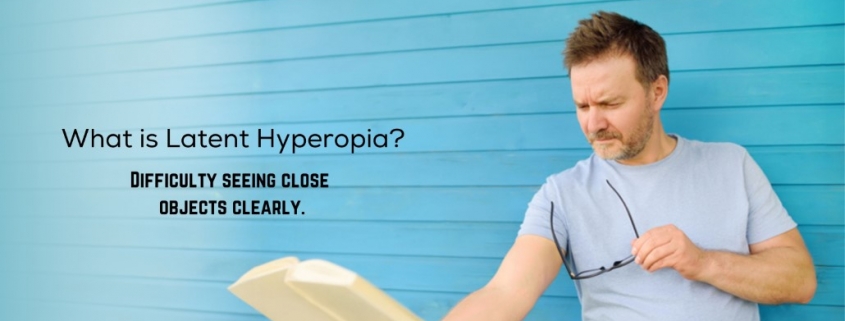What is Latent Hyperopia? Understanding Hidden Farsightedness
Latent hyperopia, a less commonly discussed eye condition, can significantly affect one’s vision and daily life. Understanding this condition is crucial for maintaining optimal eye health and preventing long-term complications. While many people are familiar with more common refractive errors like myopia (nearsightedness), latent hyperopia remains under-recognized.
What is Latent Hyperopia?
Latent hyperopia, also known as hidden farsightedness, is a condition where the eye tends to focus light behind the retina rather than directly on it. This occurs because the eye’s natural lens is too weak to bend light adequately, causing distant objects to appear clearer than those up close. While many people with latent hyperopia might not immediately notice issues with their vision, the condition can still lead to significant eye strain and discomfort over time. Regular eye examinations are crucial for maintaining eye health and identifying any refractive error that could contribute to Latent Hyperopia. An important aspect of understanding latent hyperopia is recognizing how the light focuses improperly, causing the eyes to work harder to see clearly.
What Causes Latent Hyperopia?
Latent hyperopia is primarily caused by a refractive error in the eye’s ability to focus light. This error often results from a shorter-than-average eyeball or a less curved cornea, causing light to focus behind the retina rather than directly on it. As a result, the brain works harder to adjust focus, leading to eye strain and blurry vision.
Genetic factors play a significant role; individuals with a family history of farsightedness or eye strabismus are more prone to develop latent hyperopia. The eye’s natural lens may also be too weak to bend light adequately, further contributing to the issue. Environmental factors, such as prolonged close-up tasks, can exacerbate latent hyperopia by increasing the strain on the eyes. Regular eye examinations, including cycloplegic refraction, are crucial for diagnosing this condition
What are the Symptoms of Latent Hyperopia?
Latent hyperopia often presents with subtle symptoms that can escalate over time. The most common symptoms include eye strain, especially after prolonged periods of reading or other close-up work. Blurry vision is another frequent complaint, as the eyes struggle to maintain focus. Lazy eye, or amblyopia, might develop in severe cases where one eye becomes significantly weaker. Additionally, some individuals might experience crossed eyes or strabismus, where the eyes do not align properly. An eye examination is crucial for diagnosing these symptoms accurately, as latent hyperopia can be easily overlooked. The symptoms arise due to the eye’s constant effort to refocus light that naturally falls behind the retina, leading to chronic eye strain and discomfort.
Is Latent Hyperopia a Permanent Disorder?
Latent hyperopia is not necessarily a permanent condition, but it does require ongoing management. The degree of refractive error might change over time, especially in children and young adults whose eyes are still developing. Regular eye examinations are essential for monitoring changes in vision and adjusting corrective measures as needed. Without appropriate intervention, the condition can lead to persistent eye strain and the potential development of more severe issues such as lazy eye or eye strabismus. Maintaining good eye health through regular check-ups and corrective measures can help manage the condition effectively.
How is Latent Hyperopia Treated?
The treatment for latent hyperopia typically involves corrective lenses or glasses. These aids help to refocus light directly onto the retina, alleviating symptoms such as eye strain and blurry vision. In some cases, particularly for younger patients, eye exercises might be recommended to strengthen the eye muscles and improve focusing ability.
Cycloplegic refraction plays a crucial role in determining the precise prescription needed for corrective lenses. For those with significant symptoms, especially if crossed eyes or lazy eye is present, more intensive therapies or even surgical interventions might be necessary. Regular eye examinations are critical for ensuring that the prescribed treatment effectively addresses the refractive error. Addressing how light focuses behind the retina through corrective lenses can significantly improve eye comfort and vision clarity.
Does Latent Hyperopia Improve with Age?
The progression of latent hyperopia can vary depending on several factors, including age. In children, the condition might improve as their eyes grow and develop. However, this is not guaranteed, and regular eye health check-ups are vital to ensure proper vision development. For adults, the condition might remain stable or worsen slightly with age. It’s essential to maintain regular eye examinations to monitor any changes in refractive error and adjust treatments accordingly. While some individuals might experience a natural improvement in distance vision as they age, close-up vision tasks might still pose challenges without proper corrective measures. Consistent monitoring and proactive eye health practices are essential for managing latent hyperopia over a lifetime.
By addressing the refractive error that causes latent hyperopia, one can alleviate symptoms like eye strain and blurry vision and prevent complications such as lazy eye and eye strabismus. Ensuring that light focuses correctly on the retina is essential for clear vision and eye comfort. As one age, staying vigilant about eye health and seeking regular eye examinations can help you adapt to changes in your vision and maintain a high quality of life. Keeping track of the amount of farsightedness and understanding the impact of distance vision on daily activities are key aspects of managing latent hyperopia effectively.
How Do I Know If I Have Latent Hyperopia?
Detecting latent hyperopia can be challenging because it often goes unnoticed during regular eye examinations.
One of the key diagnostic tools for identifying this condition is cycloplegic refraction. This test involves using eye drops to temporarily paralyze the ciliary muscle, preventing the eye from adjusting its focus. By doing so, eye care professionals can accurately measure the amount of farsightedness present.
Symptoms such as eye strain, blurry vision, or difficulties with close-up tasks might prompt an eye examination. If you experience crossed eyes or eye strabismus, it might also indicate the presence of latent hyperopia. These symptoms occur because the eye struggles to focus light correctly, leading to a need for frequent eye health check-ups to monitor any changes.






